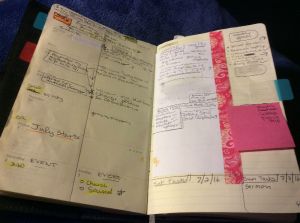 Yesterday I posted about my need to make and work plans so that I can manage a rather large plate of commitments. Today, I will give you a brief overview of how I do that.
Yesterday I posted about my need to make and work plans so that I can manage a rather large plate of commitments. Today, I will give you a brief overview of how I do that.
My time management system is a blending and simplification of the Getting Things Done and Bullet Journal systems. Both systems can get quite complicated and since I don’t want to make any more work for myself, I just use a few of their basic tools.
In my system, the key components are the Brain Dump, Organizing, Scheduling, and Execution.
The Brain Dump. This is simply taking a piece of scrap paper and writing down things you need to do. Write everything on your mind. Don’t worry, you’ll be thinking of plenty you need to do. What makes brain dumping successful is NOT stopping to organize or prioritize. Just write down one thought after another until you cannot think of anything else. Everything will be mixed up. That’s okay. You’ll straighten it all out soon. Brain dumping could take 30 seconds or 30 minutes. Here is a sample of a brain dump on did last Sunday covering what I need to get done this week (Yes, it is supposed to look incoherent):

Organizing. Once the brain dump is completed, then you start organizing it. When I review my dump, first I decide which of the items I wrote down are actionable. If any are not, then I cross them off. Next, I take what is left and divide them into three areas: Singular tasks, Events and Appointments, and Projects.
Singular tasks are simply that. I typically group the tasks accordingly: Household/Administrative, Health/Well-being, Church, Spiritual practice, Reading, Writing, Shopping, Payments, and Long-range tasks. I look at last week’s pages in my planner and note any tasks I did not complete and move them forward to this week.
Events and Appointments: I look at my monthly calendar and future log (more on this in another post) and note any appointments or events for this week. I make a chronological list of them with the date, time, location and tasks needed to prepare for them. If you are using a pre-printed planner you may have already written your events and appointments down on the appropriate day.
Projects: Projects are made up of multiple tasks required to accomplish the project. I break the project down into actionable tasks and write them down. I look at last week’s pages of my planner to see if there are any uncompleted projects and move the appropriate tasks forward to this week. I look at my future log and long-range goals for projects that need to be started. I often use a separate piece of paper or page in my planner to break down a project into tasks.
Scheduling. Now I divide a page of my planner into seven boxes with the day and date of the week. (You can use a planner with the dates already printed except you need a planner with enough room to write tasks for each day.) I write down the appointments first. Then I write down the tasks needed to prepare for the appointment on the preceding days. Next I schedule the high priority tasks and note them with a star. Finally, I schedule simple tasks and project tasks on days when I think I have the time to do them. If I don’t think I will have time to do a task then I put it in a box called “Long Range”.
Execution. All of this organizing and writing is worthless if you don’t do the tasks. This means you have to exercise a little discipline and just do the stuff! Each morning look at the day’s tasks. As you complete each task, check it off. One day at a time. This is Bullet Journaling in action. Many Bullet Journalers employ complicated codes and colors to manage their bullet lists. I just use four: a star to denote a high priority task, a check to show I completed a task, a cross-out for canceled events, a right arrow to denote that a task needs to be moved forward to the next week.
Here is my Bullet List for the week of June 5-11:

Examples: You can see my categories of tasks on the left and then the days of the week on the right with those tasks written in on the days that work best for getting them done. For example, I did household tasks on Monday because I did not have any events that evening. An example of a writing project task list: I listed that I needed to review prompts, outline a blog post, research the post, write it and then post it. Most of these tasks I scheduled for Sunday. On Tuesday, I had noted that I had to vote — an event/appointment. So on Monday, I scheduled time for me to review the ballot in preparation of that event.
So there you have the basics of my time management system. It may seem like a lot of work, but it isn’t really. It takes a few minutes on Sunday morning to brain dump, organize, and schedule and a few seconds each morning and evening to review the daily tasks.
Again, it’s the only way I can stay on top of things.
Save
















